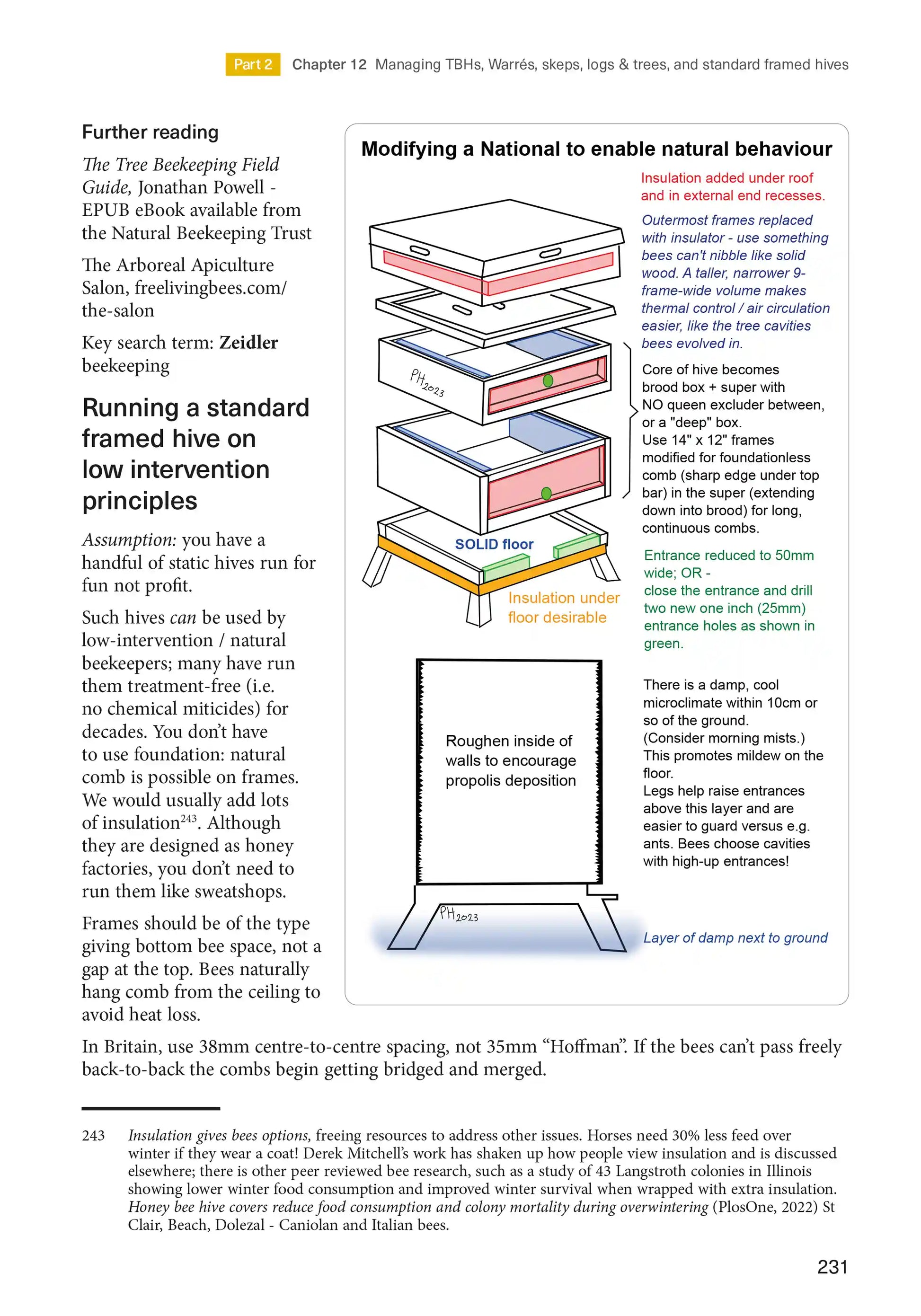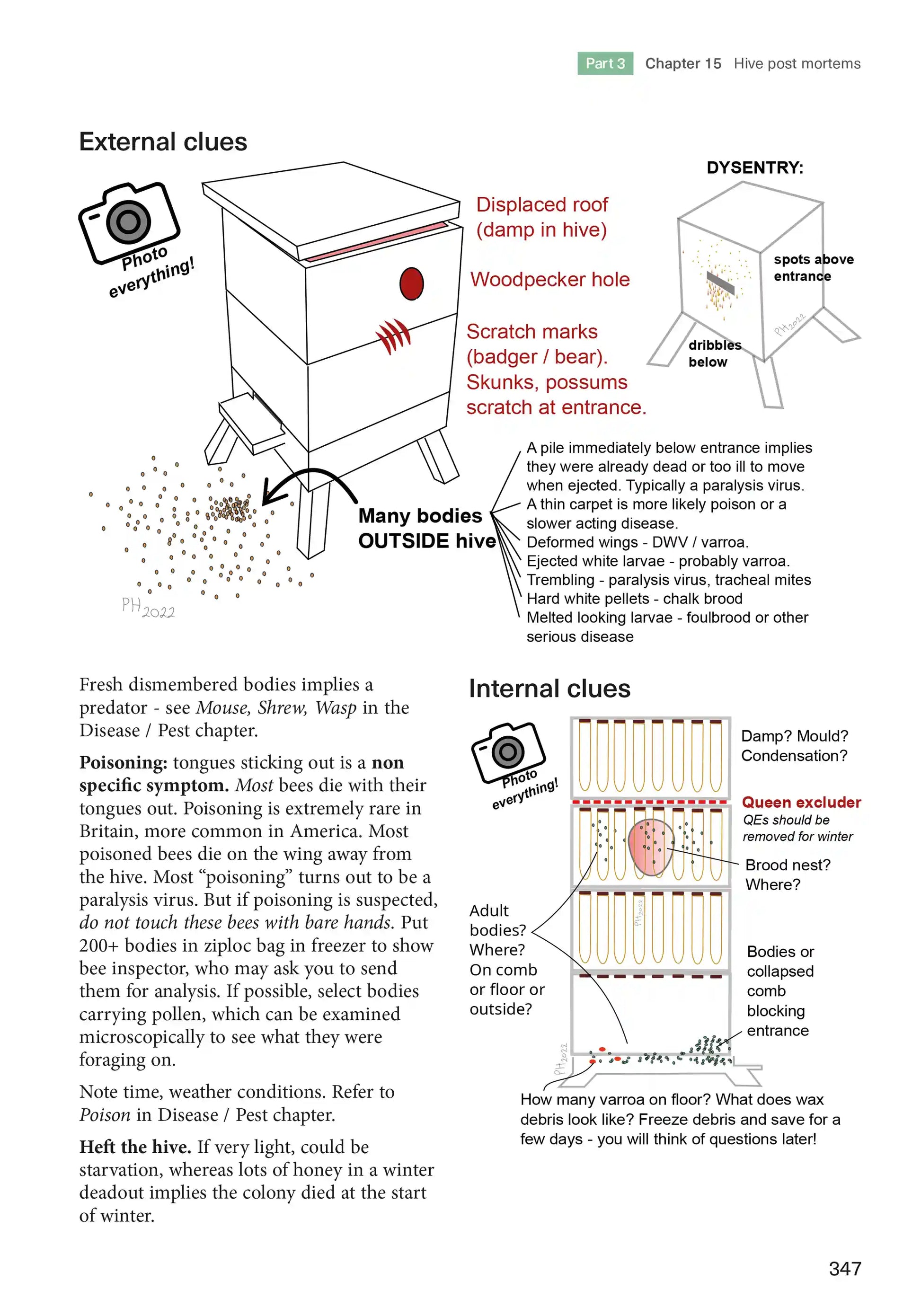The Observant Beekeeper by Paul Honigmann



The Observant Beekeeper
What makes this textbook stand out from others is the concise clear explanations and reasons for carrying out procedures with the pros and cons for each considered. ...a new beekeeper could start from scratch using only this comprehensive manual. – Ann Chilcott (The Beelistener)
There are number of books out there covering in part, similar topics, but it’s hard to find one that packs so much information into a single volume.... "The Observant Beekeeper" promises to be an indispensable reference manual for years to come. – Simon Kellam (Natural Bee Keeping Trust)
Most of the contents of Honigmann's book are not contained in any of the others... His approach is based on direct observation rather than blindly accepting what you read in books. A very practical guide... devotes space to 'reading the bees' something that has become a lost art... Lots of references and footnotes... a very thought-provoking and important book. – Norman Carreck (The Beekeepers Quarterly)
- How can you inspect a hive without opening it?
- When you do open it, how do you interpret what you see?
- And how do unmanaged bees survive without our help?
Truly seeing and understanding what is happening in a bee colony is the core skill for all beekeepers. In this comprehensive book you will learn how to ‘read’ bees’ behaviour, interpret comb clues, diagnose and deal with diseases, manage multiple hive types from framed to logs, recognise when well meant advice doesn’t apply, the tradeoffs of different management styles, and what happens when bees manage themselves.
There’s more. Information for beginners and experts alike. How to catch and use swarms – and why they don’t always behave as you expect. Races, breeding and genetics. Lost bee lore. Hive autopsies. Apiary setup. Wild bee nests. Hive variations. Treatment free strategies. Obscure behaviours. Finding queens. Honey. Propolis. Protective gear. Pitfalls of feeding. Proper use of smokers.
Paul Honigmann has been keeping bees in Top Bar Hives and Warrés for fourteen years, organises the Oxfordshire Natural Beekeepers and researches bees obsessively. This book is an expanded version of his Low Intervention training course, with details not just on how to do things, but why, and the pros and cons of alternatives.
Organised to help you find information quickly, with a logical structure, clear diagrams and troubleshooting guides for use in the apiary when you need to make rapid sense of ambiguous situations.
VIEW Contents
- Preface
- Introduction
- Why Observational Beekeeping - What it is; why beekeeping advice varies; common misperceptions
- Bee behaviour - What to expect; aligning your practices with bees’ needs
- Lifecycle and biology - Castes and variants; how roles change with age and time of year; queens, princesses and supersedure; lifespan; sleeping; bee senses
- Hive selection - General principles; choosing one fitting your needs. ~11 specific types discussed
- Apiary setup - Site selection; arrangement; obtaining bees
- Safety for bees and humans - Avoiding stressors; protective clothing; appropriate behaviour; dangers for bees
- Practical points about keeping bees - Common errors; honey basics; propolis; converting from standard to treatment-free style; finding information; costs
- The annual cycle - Colony rhythms; seasonal beekeeping activities; making your own bee calendar
- Swarms - Colony reproduction; types; swarm collection; bait boxes; hiving; care
- Harvesting honey - The if, when and how of assessing honey stores; harvesting; processing
- Observing a colony - Watching; learning; interpreting; record keeping
- Record keeping
- External monitoring - Interpreting colony state without opening a hive
- Internal inspections - The if, why, when and how of opening hives
- Reading comb - What do comb patterns and structure reveal?
- Hive management - TBHs; Warrés; Skeps; Logs & Trees; and standard framed hives
- Tips and techniques - Key skills: processes and pitfalls
- Pests, diseases and disorders
- Overview - Patterns across viruses, bacteria, fungi and pests; wild colony health and strategies; problematic beekeeping; historical incidence of disease; research; nutrition; stress and hormesis; heirarchy of needs; commensality; complacency
- Specifics - ID / diagnosis charts; alphabetic listing of over 40 conditions with symptoms, discussion, photos / diagrams and treatment options
- Conducting ‘post mortems’ - Analysing and learning from failed colonies
- Bee genetics - Insect DNA; breeds and breeding; family relationships
- Reflections on common assumptions - Some standard advice examined in detail
- Conclusions - Summing up, moving on
Part 1: Getting started - understanding bees, hives, and apiary setup
Part 2: The beekeeper’s year - what to expect, check and manage
Part 3 - Beyond the basics - health, genetics and further reflections
- Further reading
- Afterwords and evaluating advice
- Acknowledgements
- Citizen Science
- Index
VIEW Book Review
Reviewed by Ann Chilcott (Scottish Expert Beemaster) and author of THE BEELISTENER
The Observant Beekeeper: A Practical Manual Treatment free, low intervention by Paul Honigmann is a timely publication for the many experienced and new beekeepers currently seeking to change their management strategies and align their styles more closely with an environmentally aware, and minimal handling approach. This detailed “how to” manual offers ways to successfully reduce invasive colony manipulations and chemical treatments. It enables a beekeeper to look after honey bees in a mindful way that works in tandem with their natural biology and behaviour. It is the first of its kind in the UK and a valuable contribution to beekeeping education.
Honigmann is an experienced beekeeper with a passion for learning all he can about bees and sharing his knowledge with others. He started the Oxfordshire Natural Beekeeping Group which is a support system for alternative beekeepers. It was originally a local self-help group but has grown to provide regular blog posts and support beekeepers across the world.
This book is based on teaching material used in the author’s beginner beekeeping classes and focusses on self-directed learning and promoting independent thinking and decision making. Review boxes at the end of most chapters invite the reader to summarise thoughts and make notes.
There are 18 chapters divided into 3 parts covering how to get started, a beekeeper’s year, and further reflections on health, genetics, and current beekeeping challenges. The price reflects the nature of this publication which is an intricately produced textbook jam-packed full of valuable information presented in an easy-to-read format enhanced by at least 400 diagrams, drawings, tables, and photographs. Around 400 footnotes and references are found at the bottom of each page and reflect the author’s wide scientific research which backs up advice and explanations. Many of the references are based on anecdotal evidence but this is a good thing because it draws on the collective intelligence of other experienced and well-known beekeepers which endorses credibility.
There are many different ways to keep honey bees such as conventional beekeeping where the emphasis is on manipulating colonies for honey production, (varroa) treatment-free, or natural beekeeping. Honigmann is clear, “Observational Beekeeping is not specific to one system.” He is open to all beekeeping systems and is a current member of the British Beekeeper’s Association (BBKA) whose teaching is largely conventional, but they too are open to finding new ways to reduce the reliance on chemical treatments for varroosis. The BBKA will be interested in this new textbook, and its value on their recommended reading list for new beekeepers.
What makes this textbook stand out from others is the concise clear explanations and reasons for carrying out procedures with the pros and cons for each considered. This encourages new beekeepers to think for themselves and make decisions based on their own conclusions. There are no rigid rules to be followed. It is written in the modern style for the busy reader who wants to reach the salient points quickly. Honigmann uses clear headings, lists, and bullet points.
As the title implies, this style of beekeeping is about spending more time watching a colony from outside the hive rather than opening it up frequently to look through all the frames. It is also about acknowledging the differences among colonies and letting them work at their own paces throughout the season. It is acknowledged that this is not something bee farmers are likely to have much time for owing to the sheer volume of their work. This is not about honey production or queen breeding which is well covered in other publications.
The chapters on hive types, and the detailed management required for each type, are particularly useful. Having tried a few different hive types, Honigmann writes from practical experience giving lucid explanations for new beekeepers bamboozled by lists and photographs of different types. Honigmann discusses hive thermodynamics and recent research. 25% of colony heat is lost in winter through the open mesh floor but this can be mitigated by closing it and adding foil insulation below the roof. Did you know that top bee space can increase thermal loss by 70%?
The rationale for not clipping queen’s wings is reasonable, practical, and unemotional. Wing clipping usually results in prime swarms with multiple virgin queens which are less cohesive and consequently less successful. There are many useful tips and pieces of advice that everyone can learn from in this textbook. Do you know what a Russian scion is? I didn’t till now but I’m going to make one for next swarm season.
The reasons behind not selecting for particular traits in queen breeding are worthy of considerable reflection. One cannot select for all desirable traits, and by selecting for prolific laying, for example, the beekeeper ends up with queens that do not turn off egg laying during a dearth. These colonies are less adaptable and have to be boosted and fed by the beekeeper and are thus not allowed the freedom to survive by nature of their own genes.
The Observant Beekeeper is for everyone with an interest in making beekeeping easier for themselves and the bees, and for those interested in learning how bees were kept in the days before varroa. The author has achieved his goals and a new beekeeper could start from scratch using only this comprehensive manual.
Unavailable